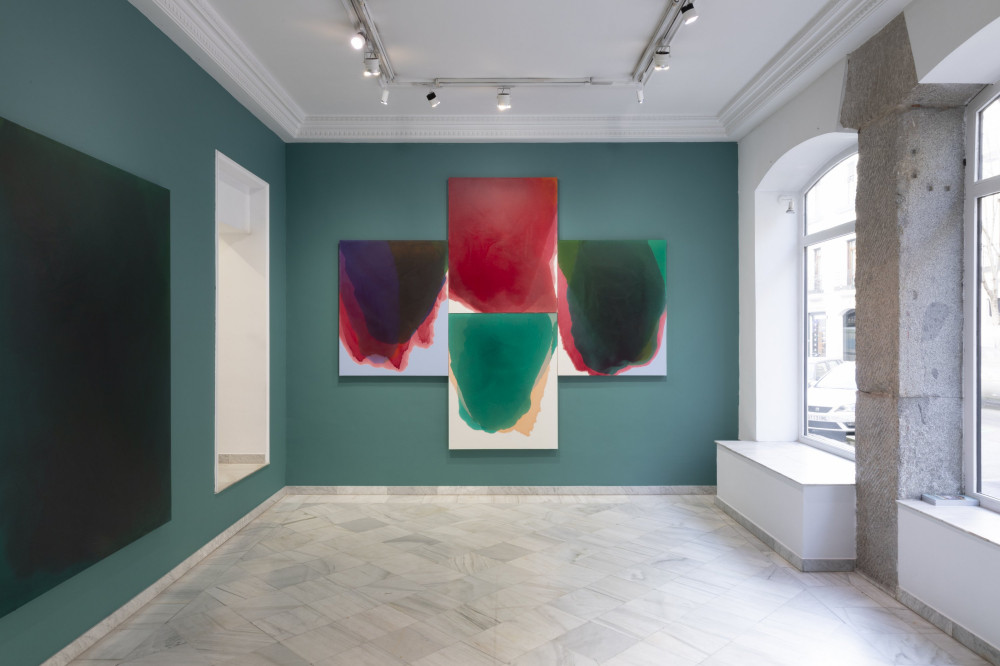
RUBÉN RODRIGO. Apostles. Three Studies for a Crucifixion
18 Feb - 13 Apr 2021
Rubén Rodrigo (Salamanca, 1980) presents his second solo exhibition at Galería Pradilla. Apostles. Three Studies for a Crucifixion is his most recent project where he makes use of an emblematic staging of the crucifixion as an artistic thematic upon which to reflect about the meaning of change, transformation and evolution that it entails, digging its plastic and conceptual roots in the works of classic and contemporary artists such as El Greco, Velázquez or Francis Bacon.
The series of middle- and large-size canvasses that make up this exhibition have been conceived by the artist as a kind of “chromatic-pandemic” diary, marked by those pictoric atmospheres overflowing with light and colour that are the distinguishing traits of his work. The exhibition furthermore includes a selection of works from the series “Apostolate” completed by the artist in 2020 and about which the artist highlights his interest in “the cosmic aspect of the Apostolate, understanding the 12 as an astronomic, solar number, the number of time par excellence. A time that had been gifted unto us and robbed at the same time in the use and un-enjoyment of a mundial crisis without precedents. In this mystical encloisterment where we have suffered in our particular connections with God (WIFI), it isn’t surprising to establish parallels with John of the Cross or Teresa of Ávila…”
This new project by Rubén Rodrigo comes accompanied by the reflections of the critic and art curator Carlos Delgado Mayordomo, from whose catalogue text we extract these fragments:
[...] The aesthetic decisions of Rubén Rodrigo seek new fields of pictoric imaginary. His discourse does not slide toward hybridation or conceptual excess, the seduction of the abject or the rhetoric of the gesture. On the contrary, upon the canvas he traces the opening of a clean, diluted stain, with a deceivingly uniform aspect, upon which he develop a pondering of its possibilities: spatial conflicts, negation of the image origin, tensions between order and instability and, above all else, the sensitiva animation of colour. A painting that rejects the wholeness and transparency of meanings, highlighting instead the complexities of perception: from a distance, his canvasses are coursed by monochrome veils which unfold, wrap and unwrap; in close distance, intersections of colour they produce subtle contrasts and unforeseen rhythms. The referential identification which lies even in the most radical form of abstraction, kept in suspense: are we looking at clouds, veils or watery shapes? In truth, we are looking at the representation of a liquid in movement, by way of a liquid in movement. The trace itself of a process.
The pieces that make up this exhibition were created during the restrictions brought by the first COVID-19 wave in Madrid. The artist has referred to these series on the apostolate of El Greco as “a chromatic-pandemic diary,” that is, a reflection which is mediated by the duration and the experience within a given time frame; this doesn’t refer to a lineal, progressive and technological time, but rather an unheard of rhythm, strange, emotive, paused, confined and reflexive. We perceive, regarding previous series, a chromatic adjustment toward more saturated tones, dark, as well as a series of acid and complex contrasts. Also, a methodological change of note: the cultural instrument of abstract appropriation allows him to rehearse an interpretative exercise upon the various chapters of tradition, from a humble position, open to a constant discovery.
Thus, from El Greco he is interested in that which constitutes his extravagant rarity: that constant psychic interpelation to the spectator, which Rubén Rodrigo understands as a question of composition and chromatic intensity. Among his modern affinities, American abstract expressionism and other fellow poetics are unavoidable references for him, as well as the (neo)figurative painting of Francis Bacon. In the visual inventory shaped by this exhibition, Rubén Rodrigo directs his gaze towards the backdrops of the English painter, those where Deleuze used to see a structuring, spatializing function.
Rubén Rodrigo’s speculation about these artists doesn’t have as objective to get to know something (an ideal rule), but to operate within a state of perpetual learning. His own methodology, which allows liquid painting to open up its own gravitational trajectory, places him in a quest that cannot be deemed normative, but rather always open to imagination and its possibilities. In his review of the history of painting, Rubén Rodrigo doesn’t propose an ironic or critical position with regards to its validity as discourse; the point is to express the meaning of a given painting, the implicit logic whereby something is constructed as image which burns, the exact place where the ashes still lit up sparks. We could perhaps name this pulsion that the artist looks for as “symptom”: an excessive sign alien to conscience, a point of suture overcharged with meaning. A place where painting expresses something that only it can be able to say.
Carlos Delgado Mayordomo
Rubén Rodrigo received a BA in Fine Arts from the Salamanca University in 2004, and has since then shown his work in solo and group exhibitions across various cities and Spanish institutions such as the already mentioned DA2 in Salamanca, the University of Granada, the Fundación Antonio Gala de Córdoba and La Fábrica in Madrid, among others. In 2020 he participated in the international art fair ZONA MACO (México, DF), presenting a Solo Project in the SUR section, and only a few months later he opened up in the Galería El Museo in Bogotá, his first solo exhibition outside of Spain.




































